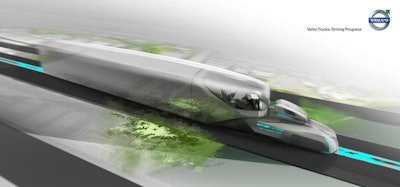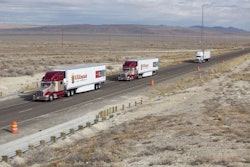
Volvo’s 2016 model-year tractors have incorporated a number of SuperTruck project-related advancements, including a number of powertrain and tractor fairing design changes, which have resulted in added fuel efficiency gains of 3.5 percent for aerodynamic performance improvements and 2 percent for powertrain improvements.
“We are putting a lot of effort into this area to gain extra advantage in our products,” said Göran Nyberg, president of Volvo Trucks North America regarding fuel efficiency improvements. “It’s about drivetrain optimization and aerodynamics, and also about finding new ways of building a truck and fine-tuning specifications for dedicated routes and needs. No longer does one size and design fit all needs.”
Volvo Group North America’s Tony Greszler, vice president of government and industry relations, previewed the company’s forthcoming predictive cruise concept with predictive shifting.
“As the truck approaches a hill, the terrain information is preprogrammed into the truck and it knows altitude change and the location of the hill’s crest. As a truck comes into the hill it automatically speeds the truck to delay downshifting, controls speed coming over the hill and uses the truck’s momentum and stored energy on the downhill portion to accelerate and get better roll-off.”
Nyberg said with technology advances and vehicle-to-vehicle communications, there is far more potential to improve safety in the trucking industry.
Susan Alt, senior vice president of public affairs for Volvo Group North America, said one such concept is platooning vehicles, adding that autonomous vehicles may not be a reality during our lifetime.
As Alt explained, Volvo’s vision for a platooning solution involves only two trucks, one lead vehicle piloted by a driver and a second trailing vehicle with a driver seated behind the wheel in case he needs to take control. The second vehicle would have a video display with a camera feed of road conditions in front of the lead vehicle.
“The real benefit is fuel efficiency,” she said. “The first truck gets better efficiency because or reduced wind drag behind the trailer, and the second truck gets better draft behind the first truck.”
Like autonomous trucks, platooning solutions also face regulatory and public acceptance hurdles, she said.










